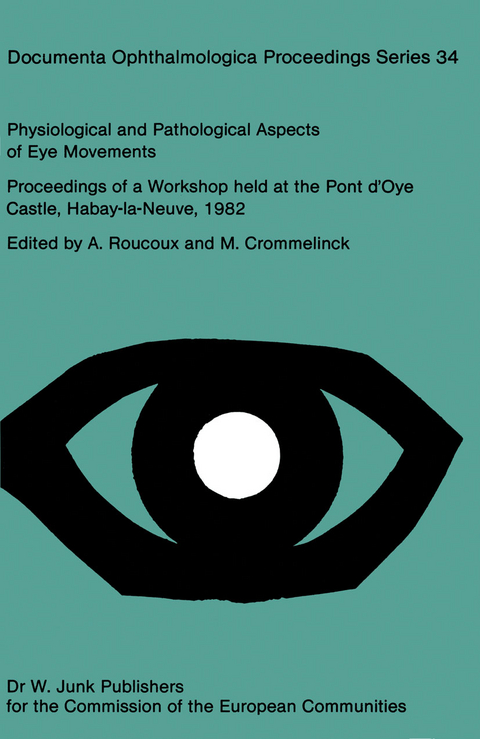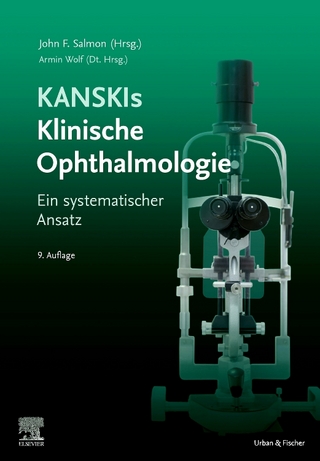
Physiological and Pathological Aspects of Eye Movements
Kluwer Academic Publishers (Verlag)
978-90-6193-730-2 (ISBN)
- Titel z.Zt. nicht lieferbar
- Versandkostenfrei innerhalb Deutschlands
- Auch auf Rechnung
- Verfügbarkeit in der Filiale vor Ort prüfen
- Artikel merken
This volume contains the proceedings of a work shop entitled "Physiological and Pathological Aspects of Eye Movements" held at the Pont d'Oye Castle, Habay-Ia-Neuve, Belgium, March 27-30 1982. The meeting was sponsored by the European Communi ties. It brought together specialists of oculomotricity mainly from Europe but also from North-America. With such actions, the Communities want to encourage inter national and multidisciplinary contacts between re searchers of a particular field. Oculomotor neuroscien tists, for quite a long time, have developed such con tacts. This cooperation - this is not so common in biological research - embodies various approaches, from basic mechanisms to behavioral studies, but also this applied science that medicine is or should be. Many basic discoveries about eye movement mechanisms, made with the help of human of animal subjects, have found rapid medical applications in neurology, neuro ophthalmology or otolaryngology. This is illustrated in this book by the fact that results obtained on rats or cats are interspersed with reports of clinical in vestigations. The workshop was mainly focused onto three themes: (a) eye and head movements in man, (b) visuo-vestibular interaction and (c) eye-head coordination. In each theme, one or more "review" papers were included. In addition, most of the oral presentations or posters on display mainly contained unpublished material.
Section I: Gaze Displacement in Man.- Control of gaze in man: synthesis of pursuit, optokinetic and vestibulo-ocular systems.- Gaze fixation and pursuit in head free human infants.- Predictive mechanisms in human smooth pursuit movement.- Biphasic aftereffects of vestibular stimuli, optokinetic nystagmus and pursuit -Common integrators?.- The coordination of pursuit and saccadic eye movement in the scanning of a moving scene.- Dependence of saccadic prediction on asymmetrical periodic stimulus.- Can training be transferred from one oculomotor system to another?.- Acquired pendular nystagmus: characteristics, pathophysiology and pharmacological modification.- Eye movement disorders in multiple sclerosis and optic neuritis.- The measurement of eye movement using double magnetic induction.- Section II: Vestibulo-Ocular Refle.- The vertical vestibulo-ocular reflex.- Single unit recordings in the vestibular nuclei of the alert monkey related to the vertical vestibulo-ocular reflex (WOR).- The brain-stem matrix of the vestibulor-ocular reflex.- Compensatory eye movements in the monkey during high frequency sinusoidal rotations.- Concerning the linear acceleration input to the neural oculomotor control system in primates.- An intracellular HRP study of abducens motor and internuclear neurons in the alert squirrel monkey.- Section III: Optokinetic Refle.- Anatomy and physiology of the optokinetic pathways to the vestibular nuclei in the rat.- The role of the fovea and parafoveal regions in the control of “fast” optokinetic responses in the monkey.- The role of central and peripheral retina in eliciting optokinetic nystagmus in cats.- Possible contribution of the cortical areas 17, 18 and 19 to the optokinetic response in the cat.- Section IV: Effects of Lesions on VOR andOKN.- Influence of bilateral plugs of pairs of semicircular canals on optokinetic and vestibuloocular reflexes.- Vestibuloocular and optokinetic reflex compensation following hemilabyrinthectomy in the cat.- Gaze palsies after selective pontine lesions in monkeys.- The role of the primate flocculus during vestibular and optokinetic nystagmus: single cell recordings and lesion studies.- Effects of bilateral occipital lobectomies on eye movements in monkeys: preliminary observations.- Section V: Visuo-Vestibular Interaction.- Models of visual-vestibular interaction in oculomotor control: a review.- Neuronal responses in the parieto-insular vestibular cortex of alert Java monkeys (maccaca fascicularis).- Linear interaction of vestibular and optokinetic nystagmus.- The effects of retinal location and strobe rate of head-fixed visual targets on the suppression of vestibular nystagmus.- Section VI: Saccadic System.- A stochastic model of central processing in the generation of fixation saccades.- Responses of the saccadic system to sudden changes in target direction.- Spatio-temporal recoding in the generation of rapid eye movements.- Horizontal saccades induced by stimulation of the mesencephalic reticular formation.- Tectal control of vertical eye movements: a search for underlying neuronal circuits in the mesencephalon.- The localization of large and small motoneurons in the oculomotor nucleus of the monkey.- Section VII: Eye-Head Coordination.- Role of vestibular and neck reflexes in controlling eye and head position.- Modification of VOR slow and quick components by neck stimulation and turning sensation.- The relation of neck muscles activity to horizontal eye position in the alert cat. I: Head fixed.- The relation of neck muscles activity to horizontal eye position inthe alert cat. II: Head free.- Brain stem neurons mediating horizontal eye position signals to dorsal neck muscles of the alert cat.- Behavior of pontine cells during eye-head coordination: evidence of gaze shift coding by preoculomotor bursters.- Coordinated eye-head movements in the cat.- Dynamics of compensatory vestibular reflexes in the grassfrog, rana temporaria.- Visuo-spinal ataxia caused by disorders of eye movements.- Eye-head-hand coordination.- List of Participants.
| Reihe/Serie | Documenta Ophthalmologica Proceedings Series ; 34 |
|---|---|
| Zusatzinfo | 456 p. |
| Verlagsort | Dordrecht |
| Sprache | englisch |
| Themenwelt | Medizin / Pharmazie ► Medizinische Fachgebiete ► Augenheilkunde |
| ISBN-10 | 90-6193-730-2 / 9061937302 |
| ISBN-13 | 978-90-6193-730-2 / 9789061937302 |
| Zustand | Neuware |
| Haben Sie eine Frage zum Produkt? |
aus dem Bereich


